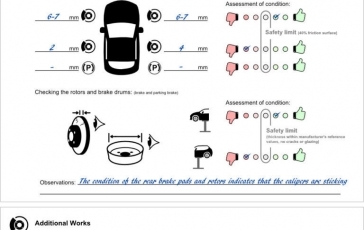Brake Service and Maintenance
Brake service and repair is probably one of the most common additional jobs that are linked in connection to the interval service. Every mechanic has to master the basics of brake servicing and be able to perform it on different brake system structures, be this an older passenger car or a new electric car.
- Recognising different structures and components, and knowing how they function
- Assessing the need for service and repair
- Front- and rear brake service
- Drum brake service
- Attending to electric- and mechanical parking brakes
- Brake cylinder inspection and service
- Bleeding the brake fluid circuit correctly
- Changing the brake fluid
- Description
- Videos
WHY THIS TRAINING MODULE?
Brake service is an essential part of the work required on a vehicle, especially for mechanics. Brake component wear needs to be checked regularly, you assess the condition, and perform the service or replacement of the parts. Brake service is part of the basic skills for a mechanic, both at work and in training.
WHAT WILL YOU LEARN?
You begin learning about brake servicing by familiarising yourself with typical structures and components. You learn the names of components which comes in handy e.g. when ordering parts.
When the structures are familiar you go on to assessing the service requirements. You find out how inspections are done during test-use and while lifted on the vehicle ramp.
When you put these skills into practice, you notice how difficult doing a complete assessment of the service need is without disassembling the structures.
In the study about Front Brake Service, the service procedure is gone through step-by-step. With the help of pictures and examples you will learn more about different structures, and the disassembly of brake structures.


The training module covers a wide variety of rear brake structures, such as; disc brakes with parking brake, disc brake with separate parking brake shoes and drum brakes. Additionally, the module also covers attending to the electric parking brake, so you can avoid possible dangerous situations and damage.

After the wheel-specific brake service, the service is finished up by going more deeply into changing the brake fluid, correct bleeding procedures and examples for controlling the functionality.

The training module also consists of assessments and practical tasks to challenge your knowledge of brake servicing. Brake service, as a whole, is a task that requires strong practical knowledge and a lot of experience. The best final assessment and test of your skills is to perform a lot of brake service jobs to gain more practical competence. In your work, you can utilise the inspection card found in the printable student material. To ensure a professional service experience is delivered, you can give the correctly filled inspection card to the customer.

PREREQUISITES (PRE-KNOWLEDGE / SKILLS) FOR TAKING THIS TRAINING MODULE
To reach all learning outcomes you need to have a basic knowledge of automotive electricity and electronics. Troubleshooting skills and experience will also be an advantage.
CONTENT EQUIVALENCE

Once you have made your payment, you get immediate access to the content in the form of a license valid for 6 months. You’ll save time and money by not needing to travel.
UPDATES
We want to make sure that you always have the latest version of our product. Prodiags reserves the right to make real time updates and changes. This way you’ll always have the best version, without extra fees.
SYSTEM REQUIREMENTS
Internet connection, PC or laptop. Recommended screen resolution 1024 x 768 or higher.
CERTIFICATE
After completing your studies and appropriately completed assignments, you will complete the final exam. After completing the final test, you can print a Prodiags certificate from your performance record to mark your expertise.
LEARNING OUTCOMES
You will acquire a basic knowledge of oscilloscope operation and settings. You will understand different types of measurement mode and when to use them, and become more effective in using your current probes.












